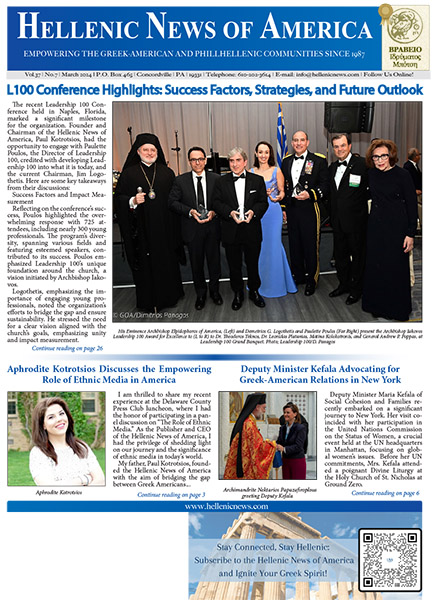Greeks, in times of crisis and prosperity alike, like to gather around a table to eat, drink, and talk, in cozy indoor spaces in the winter or outdoors for long hours during the balmy summer nights. One could argue that this ritual is their national sport.
The ritual has long roots in Greek history. The men and women who created the early Hellenic civilization and laid the foundations of our modern western world were relentless in questioning and arguing in their pursuit of knowledge, but were equally captivated by beauty and wellbeing. They had a strong sense of joie de vivre, and they celebrated life with every opportunity. The symposion (drinking together) was a highly structured ritual that provided the opportunity for drinking but not necessarily to excess, merry making, performing music and reciting poetry, playing games, and above all discoursing on pre-selected important topics and ideas. There exists a large written record attesting to this: Plutarch’s “Table Talk”, Athenaeus’s “Deipnosophistai”, Xenophon’s “Symposion”, and of course Plato’s “Symposion”, one of the most significant books of the Western literary canon, with the discussion subject of Love. Literary sources together with artifacts recovered by archaeologists -drinking cups (skyphos), mixing bowls (krater), wine coolers (psykter)- and vase paintings constitute an invaluable resource for understaning the meaning, importance, and practices of the symposion. The distinguished French scholar Francois Lissarrague in his fascinating book “The Aesthetics of the Greek Banquet-Images of wine and ritual” documents many aspects of this distinctly Greek phenomenon.
Recently a drinking cup was discovered in Kifissia near Athens that has caused much excitement in archaeological circles, but only now is it coming to the attention of the public at large. Why the excitement about another drinking cup (and apparently of not great artistic quality), when the museums of the world are replete with symposion-related artifacts? The answer is because of the cup’s inscriptions. Greek scholars have associated the cup with the great Athenian statesman Perikles, and have determined that it belonged jointly to Perikles and a coterie of five other distinguished Athenians of the 5th century B.C.
The discovery and initial evaluation were made and have been detailed by archaeologist Galene Daskalaki in the specilialized archaeological magazine HOROS. During a recent new home construction project in Kifissia examination of the foundations revealed a cluster of tombs dating from the 6th to the 4th centuries B.C. The tombs had many burial artifacts, including the drinking cup in question. It was put together from a dozen fragments. It is black-glazed, dated to the period 480-465 B.C., and its most noticeable feature is the names Perikles, Arrifron, Aristeides, and three more, six names altogether on its side; a seventh name, Drapetis, appears on the bottom. The names on the side are scratched in the Attic alphabet, and are in the genitive case indicating ownership. On the base of the cup Drapetis is notched in the Ionian alphabet. Several different handwriting styles have been identified, indicating that different people signed their names.
Given the date of the cup and the names of historical persons of the time (Perikles, Arrifron the older brother of Perikles, and Aristeides the Just), Daskalaki determined that it was quite possible that the cup belonged to the illustrious statesman Perikles. Daskalaki writes: “It is possible that Aristeides and the sons of Xanthippos, the first-born Arrifron and Perikles, found themselves in a symposion (together with the other three named) and they shared the same drinking cup, and in remembrance of the occasion they scratched their names starting from the eldest. The inscription of the word Drapetes (Fugitive) on the bottom of the cup.. was for someone who escaped, left secretly, possibly a slave. In spite of the interpretations that could be given, the find is a live, authentic item of a private moment of seven people of the 5th century.”
The distinguished epigraphist Angelos Matthaiou has also examined the cup and he supports and extends significantly the interpretation first given, providing strong historical and literary arguments to buttress the assertion. He points out the practice of an owner or user of a vessel of writing his name in the genitive case (as is here) indicating ownership; cites examples of drinking from the same cup (Homer, Euripides), and the same cup being passed among the symposiasts from left to right, as in Plato’s Symposion.
If the group’s gathering place was in Kifissia, where the tombs were excavated, what was the occasion for the prominent Athenians to be there? Matthaiou considers that Perikles and his parea went drinking in a kapeleio (inn or bar) rather than being at a formal symposion because of the low quality of the cup, which the famous patrons signed (in a not-very-steady hand) and left it with the innkeeper. He writes: “the symposiasts upon departing left the skyphos with their “signatures” to the kapeleio owner, a reminder of their visit to his shop. It is common in later years in the tavernas and the resaturants famous patrons, either on their own volition or after being solicited by the owner, to leave a memento of their having been at his place of business. The owner displays it in a prominent place of his establishment, an advertisement for future customers. How the skyphos, the “memento”, ended up in the unpretentious grave no one can tell with certainty. Perhaps when the kapeleio closed, the skyphos together with all the other possessions was moved to the owner’s home. After his death his loved ones put the “memento” in his grave as a gift”.
George Seferis, Greece’s first Nobel Prize winner in literature, in his “Mythistorema” laments that “It used to be easy for us to draw up idols and ornaments” (from the Greek “wasteland”, “Our country is closed”, he says). But despite the widespread theft and destruction, by natives and barbarians alike, of many aspects of the Greek cultural heritage, thanks to the archaeologists’ excavation efforts and the insight of the classical scholars there still seems to be an unending supply of evidence for the greatness and continuity of Greek civilization.
* Leonidas Petrakis holds a PhD in physical chemistry from the University of California, Berkeley, was Chairman and Senior Scientist of the Department of Applied Sciences at Brookhaven National Laboratory, has taught at various universities in the US, France, and Greece, did research in the private sector, and is the author of several books and of more than 150 peer-reviewed scientific publications. He now resides in Oakland, Calif.







